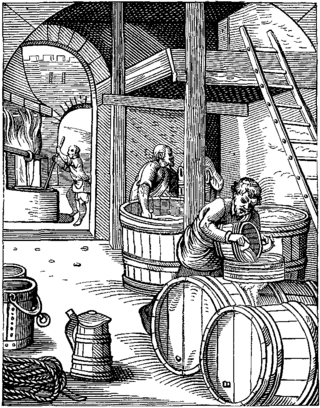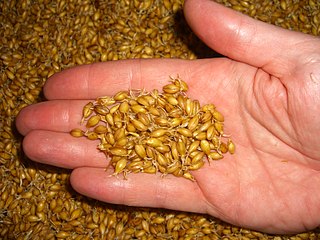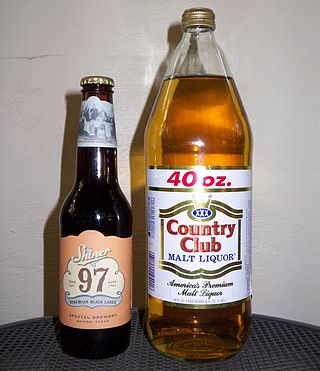
Beer is one of the oldest alcoholic drinks in the world, the most widely consumed, and the third most popular drink after water and tea. Beer is produced by the brewing and fermentation of starches from cereal grains—most commonly malted barley, although wheat, maize (corn), rice, and oats are also used. The fermentation of the starch sugars in the wort produces ethanol and carbonation in the beer. Most modern beer is brewed with hops, which add bitterness and other flavours and act as a natural preservative and stabilising agent. Other flavouring agents, such as gruit, herbs, or fruits, may be included or used instead of hops. In commercial brewing, natural carbonation is often replaced with forced carbonation.

Brewing is the production of beer by steeping a starch source in water and fermenting the resulting sweet liquid with yeast. It may be done in a brewery by a commercial brewer, at home by a homebrewer, or communally. Brewing has taken place since around the 6th millennium BC, and archaeological evidence suggests that emerging civilizations, including ancient Egypt, China, and Mesopotamia, brewed beer. Since the nineteenth century the brewing industry has been part of most western economies.

Malt is a cereal grain that has been made to germinate by soaking in water and then stopped from germinating further by drying with hot air, a process known as "malting". Malted grain is used to make beer, whisky, malted milk, malt vinegar, confections such as Maltesers and Whoppers, flavored drinks such as Horlicks, Ovaltine, and Milo, and some baked goods, such as malt loaf, bagels, and Rich Tea biscuits. Malted grain that has been ground into a coarse meal is known as "sweet meal".

Low-alcohol beer is beer with little or no alcohol by volume that aims to reproduce the taste of beer while eliminating or reducing the inebriating effect, carbohydrates, and calories of regular alcoholic brews. Low-alcohol beers can come in different beer styles such as lagers, stouts, and ales. Low-alcohol beer is also known as light beer, non-alcoholic beer, small beer, small ale, or near-beer.

Malt liquor is a type of mass market beer with high alcohol content, most closely associated with North America. Legally, it often includes any alcoholic beverage with 5% or more alcohol by volume made with malted barley. In common usage, it refers to beers of high alcohol content, generally above 6%, which are made with ingredients and processes resembling those for American-style lagers.

In brewing and distilling, mashing is the process of combining a mix of ground grains – typically malted barley with supplementary grains such as corn, sorghum, rye, or wheat – known as the "grain bill" with water and then heating the mixture. Mashing allows the enzymes in the malt to break down the starch in the grain into sugars, typically maltose to create a malty liquid called wort.

Nigerian Breweries Plc, is the largest brewing company in Nigeria. It serves the Nigerian market and West Africa.

Vitamalz is a German malt beer without alcohol.

Brown rice (malt) syrup, also known as rice syrup or rice malt, is a sweetener which is rich in compounds categorized as sugars and is derived by steeping cooked rice starch with saccharifying enzymes to break down the starches, followed by straining off the liquid and reducing it by evaporative heating until the desired consistency is reached. The enzymes used in the saccharification step are supplied by an addition of sprouted barley grains to the rice starch or by adding bacterial- or fungal-derived purified enzyme isolates.

In brewing, adjuncts are unmalted grains or grain products used in brewing beer which supplement the main mash ingredient. This is often done with the intention of cutting costs, but sometimes also to create an additional feature, such as better foam retention, flavours or nutritional value or additives. Both solid and liquid adjuncts are commonly used.

Beer is one of the oldest human-produced drinks. The first chemically confirmed barley-beer – from the area of Mesopotamia, part of modern-day Iraq – dates back to the 5th millennium BCE. The written history of ancient Egypt and Mesopotamia records the use of beer, and the drink has spread throughout the world; a 3,900-year-old Sumerian poem honouring Ninkasi, the patron goddess of brewing, contains the oldest surviving beer-recipe, describing the production of beer from barley bread, and in China, residue on pottery dating from around 5,000 years ago shows that beer was brewed using barley and other grains.

Oriental Brewery or OB is a South Korean brewery currently owned by AB InBev, and initially founded by Doosan Group.

Amylolytic process or amylolysis is the conversion of starch into sugar by the action of acids or enzymes such as amylase.

Mash ingredients, mash bill, mashbill, or grain bill are the materials that brewers use to produce the wort that they then ferment into alcohol. Mashing is the act of creating and extracting fermentable and non-fermentable sugars and flavor components from grain by steeping it in hot water, and then letting it rest at specific temperature ranges to activate naturally occurring enzymes in the grain that convert starches to sugars. The sugars separate from the mash ingredients, and then yeast in the brewing process converts them to alcohol and other fermentation products.

Grand Central is a rock/metal pub and music venue at 80 Oxford Street, near Oxford Road railway station and opposite The Principal Manchester hotel in Manchester, England. It is a four storey building which is typical of buildings that were originally houses in the late eighteenth and early nineteenth century. Wakefield Street on the southside leads to the railway station via a pedestrian stairway.

The chemical compounds in beer give it a distinctive taste, smell and appearance. The majority of compounds in beer come from the metabolic activities of plants and yeast and so are covered by the fields of biochemistry and organic chemistry. The main exception is that beer contains over 90% water and the mineral ions in the water (hardness) can have a significant effect upon the taste.

Barbican is a brand of non-alcoholic malt drinks distributed by the Aujan Coca-Cola Beverages Company (ACCBC). The drink is primarily sold in the Middle East and North Africa.

Ernest Septimus Reynolds FRCP was emeritus professor of clinical medicine at the University of Manchester. In 1900 he wrote "An Epidemic of Peripheral Neuritis Amongst Beer Drinkers in Manchester and District" for the British Medical Journal, the first of a series of papers which caused a national sensation when they revealed the presence of dangerous levels of arsenic in local beer.


















